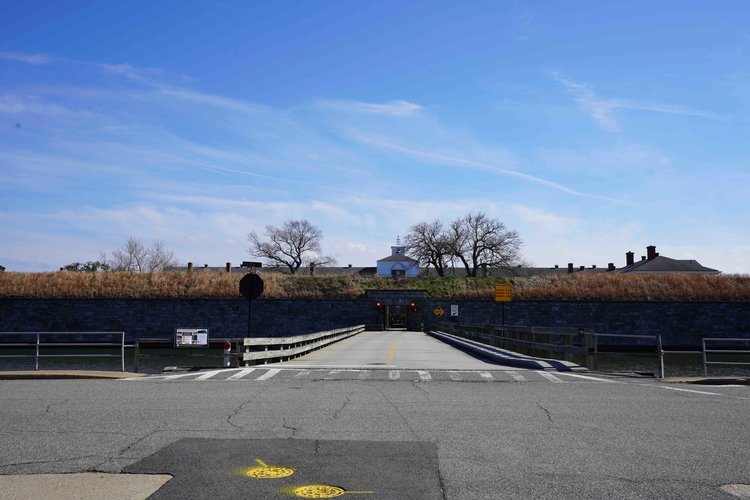Hampton, Virginia
View of the Chesapeake Bay from the top of Fort Monroe, Hampton, Virginia.
The First Slaves in Virginia
In August of 1619, an English privateer warship deposited approximately 20 African prisoners at Old Point Comfort.
The White Lion, as the vessel was known, had seized the Africans from a Portuguese slave ship that had been transporting them to Mexico.
The arrival of these prisoners in Virginia marked the start of African slavery in the Virginia colony.
Some of these slaves were transported north to the settlement at Jamestown.
Over the subsequent decades a system of institutionalized slavery would develop in Virginia and the subjection of Africans would become the foundation of the colony’s plantation economy.
Today a marker at Old Point Comfort in Hampton, Virginia denotes the approximate location were these first slaves set foot on Virginia soil.
Old Point Comfort Lighthouse and the War of 1812
On June 17th, 1812 the U.S. Senate voted to approve a resolution declaring war on the British Empire by a 19 to 13 margin.
You can view the Senate’s approval of the resolution declaring war on the British Empire here.
The House of Representatives had already voted to approve war against the British Empire by a margin of 79 to 49.
President Madison signed the bill into law on June 18, 1812, marking the start of the War of 1812.
This declaration of war was the first in American history.
(To learn more about the legal mechanisms by which the U.S. government declares war, see here).
The declaration of war was prompted by a desire among some American policy-makers to annex British Canada, frustration with European trade embargoes, the British Empire’s alliance with indigenous peoples locked in a bloody battle for survival with an America expanding westward, and British harassment of U.S. vessels in the Atlantic.
(Learn the full backstory here.)
In 1813, the Old Point Comfort Lighthouse, strategically located near the southern end of the Chesapeake Bay – the body of water any foreign navy would need to sail up in order to launch an assault on Washington D.C. – fell under British control.
The British would use the lighthouse as a lookout, monitoring movements in the Chesapeake, a sign of the importance of protecting access to this body of water to U.S. national security.
After the war, which saw the White House set alight by the British in 1814, a new fort was constructed near the location of the lighthouse to control access to the vital waterway.
Fort Monroe and the Civil War
Entrance to Fort Monroe.
A view of the moat surrounding Fort Monroe.
Location of Robert E. Lee’s residence while he oversaw construction of Fort Monroe.
Construction of a new fort, to be named after America’s fifth president James Monroe, began at Old Point Comfort in 1819.
Lieutenant Robert E. Lee, who would later command Confederate forces during the American Civil War (1861-1865), was stationed at the site early in his military career and oversaw the fort’s ongoing construction from 1831-1834.
That construction of the fort was, for a time, overseen by the eventual Confederate general is something of a historical irony considering that the Union would later use it as a prison for captured Confederate president Jefferson Davis.
President Lincoln’s quarters during his visit to Fort Monroe.
A marker noting the location of Lincoln’s residence at Fort Monroe.
In 1862, with the Civil War under way, President Abraham Lincoln visited Fort Monroe for 4 nights.
There he oversaw a successful Union effort to capture the city of Norfolk from the Confederacy.
Engineer Wharf, where a detained Jefferson Davis disembarked from a Union vessel before being imprisoned at Fort Monroe.
In May of 1865, Union forces captured Jefferson Davis, the first and only president of the Confederate States of America, in Georgia after Davis fled the sacked Confederate capital at Richmond.
He was transferred by boat to Old Point Comfort where he disembarked at Engineer Wharf.
He was then imprisoned at Fort Monroe for 2 years before being released on bail in May of 1867.
Upon his release, Davis journeyed north eventually reaching the Canadian city of Montreal where his children had been residing and the U.S. government eventually abandoned its efforts to prosecute Davis for treason.
A View from the top of Fort Monroe
A ramp to the top of Fort Monroe.
Written By: Aiden Singh Published: July 18, 2020










